a. Drawing of an ancient Greek woman riding aside
b. Statue of the Celtic Goddess Epona, Patroness of the Horse, in a Gallo-Roman Bronze. Bibliotheque Nationale
To create a workable "medieval" style side-saddle having seen only pictures and knowing no-one who had ridden in one.
I started by looking through practically every book I could and noting women riding. Here are a few highlights. In the Greek and Roman worlds, women were not portrayed on horseback often. Most of the women who are, are Goddesses and they are usually shown aside.
a. Drawing of an ancient Greek woman riding aside
b. Statue of the Celtic Goddess Epona, Patroness of the Horse, in a Gallo-Roman Bronze. Bibliotheque Nationale
I found an 11th c. painting of Mary and Joseph fleeing into Egypt. In this plate Mary rides aside and both her feet are in stirrups. I am of the opinion that this is unsafe. I also found a written reference in Hispanic Costume, that spoke of women using one or two stirrups on their saddles.
Le Petit-Quevilly, Saint-Julien, choir vault, Flight into Egypt, Detail of a vault painting. c.1183. (Dodwell)
Women are seen riding astride frequently through all of our period. Women seem to have ridden both astride and aside concurrently and all through period. Most books say that women rode only aside after about 1300 but I find that the pictorial evidence says differently. Aside seems to have be the more "ladylike" way to ride, but women of strong character seem to have broken with this regularly. As an example, in The Canterbury Tales, the Prioress rides aside and the Wife of Bath rides astride.
a. The Prioress from The Canterbury Tales, this version was printed in 1532
b. The Wife of Bath, from the Canterbury Tales, the Ellesmere Manuscript, c.1410,
the Huntington Library, San Marino, CA.
The Virgin Mary is generally portrayed aside, though there are some portrayals of her riding astride. Women seem to ride astride or aside depending on fashion. Even in the late Renaissance women ride astride, the next plate shows Queen Isobel of France by Velasquez, I am sure that there are many who will contest this but with much study, I have come to the conclusion that she must be riding astride, as there is no room for the leg to be thrown over and you cannot see her right foot as you would if she were in the modern aside position. Also the pommel of her saddle is clearly visible. I believe she is riding astride wearing a farthingale.
Queen Isabel of France by Velasquez
By contrast here are two pictures which clearly show the sidesaddle of that time. Note in the first, the women's body is slightly twisted on her horse and the right knee and both feet are clearly visible. Even where the fashion is for extremely long skirts the right toe is visible through the skirt. In the second, the lady is wearing trousers and therefore clearly shows her leg position. These ladies are riding in the "modern" position. At this time women rode both on sideways facing planchette sidesaddles and the more modern style.
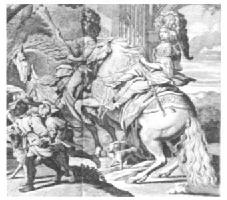
a. "Family Hunting Party"(1755/6) by Judith Lewis
b. A plate from a privately printed book commemorating a party held by the Duke of Savoy in 1674
There are many examples of women riding astride.
a. Detail from "The Effects of Good Government" by Lorenzeti
b. The sisters and cousin of Lorenzo de Medici, from the fresco,
Journey of the Magi by Benozzo Gozzoli in the Riccardi chapel ca.1459
c. Detail from the Minnesanger Manuscript
There are even more of women riding aside, in the completely sideways style. My thoughts on this are, why would someone ride this way if they couldn't go where they pleased, comfortably? After all I had found modern writers who said that ladies couldn't ride faster than a walk and that they couldn't guide their own horses. A quick glance at the historical record proved this last one wrong.
a. Detail from Tres Riches Heures de Duc de Berry
b. Detail from Two countrywomen, two fishwives and a water-carrier by J. Hoefnagel, 1574
c. Mencia de Mendoza, detail of tapestry cartoon by Bernart van Orley, ca.1530
Women also seemed to ride either "handed".
Detail from an allegory of Vices and Virtues, early 16th c. German
Modern women generally ride aside only to the near(left) side unless there is some physical handicap which precludes this. I remember reading somewhere(unfortunately I forget where!) that the Spanish ladies, who accompanied Katherine of Aragon to England, rode on the "wrong" side from the English Ladies, so there probably are regional preferences but I don't yet know what they were. I also don't yet know if women were "flopped" by "Artistic License".
I have been looking for pictures of women's saddles either extant or in portraits and haven't seen many.
a. Detail of Queen Elizabeth I's saddle from the Booke of Venerie by G. Turberville, 1572
b. Probably 17th c. sidesaddle from the Hermes Museum in Paris
c. Mexican sidesaddle with planchette, 18th c., LA County Museum of Natural History
Most saddles are shown with someone in them.
16th c. Lady from Horses in Shakespeares England by Anthony Dent
There is a real difference between a "medieval" and a "modern" sidesaddle. On a "modern" saddle the rider faces directly forward with one foot in a stirrup and the other knee over a horn.
Final Position from S. Sidney's Book of the Horse, 1874
On a "medieval" saddle the rider sits facing directly sideways and must twist in the body to face forward. Her feet are usually both on a board.
Flight into Egypt
I have little to prove it but my guess is that women "scooched" around to the front on their saddles and finally threw one knee over a modified pommel to create the "modern" version. I do know that some women were already riding in the "modern" position as early as 1495 when Albrecht Durer made this print. Note how similar the position is to the Victorian era one.
a. Detail from The Lady and the Landsknecht by Albrech Durer ca.1495
b. Detail from An Elegant Equestrienne on a Grey by Alfred de Dreux
Ever since Edward and I got interested in horses at Twenty Year Celebration, I have been making tack for whatever horse I happened to have access to. When my friend the Honorable Lady Darya found a picture of a "medieval" sidesaddle, I decided to build one like it. It is probably 17th century but I have no firm date for it yet.
A probably 17th c. sidesaddle from the Hermes Museum in Paris
I chose this design because of the high cantle and pommel and the backrest. It looked like it would give good stability. I also chose to attach it to the horse with two girths and use a crupper and breast collar. Since I had no idea of what to expect, I decided to go for as many safety features as possible. I knew I could use just a plain breast collar and crupper as the Italians of my period often used fairly plain breast collars and breechings or cruppers, sometimes with a bridle to match.
Over the years I have torn apart a number of saddles of various types to see how they were built. I have also read every book on saddle making I could find. I decided to tear apart an old western saddle and use the tree. When I got it all apart I decided it was not right for a side-saddle like the one in the picture as I wanted it to have a very flat seat. I decided to build the tree.
To save wear and tear on my feet and Briar's nerves I made a plaster-cloth mold of her back to fit the parts, so I wouldn't have to keep going out to try things on her.
As I wanted the saddle's seat to be very flat and chair-like, I decided to start with flat pieces of wood on top and build the bars up underneath to fit my horse. I got some 1/4-3/8" thick by 6-8" wood, I'm not sure what variety, but as both softwoods and hardwoods are used in tree-making, I figured that wouldn't matter. I found some nice stiff paste epoxy and set to work building the bars. After I had the basic shape, I faired in the angles with balsa wood. I then constructed the pommel and cantle of two thickness' of 1/2" plywood, laminated (for non-breakableness, and cost) and attached them to the bars with wood screws and L brackets. If I had been making this in the "period" manner I would have started with a thick piece of wood and carved it down for the bars and used planks for the pommel and cantle, and of course I would not have used epoxy. Hide glue is the more authentic glue. I might have used the L brackets but I might have just drilled holes and laced it together with rawhide strips or nailed it together.
After this it was simple upholstery. I padded the underside with closed cell foam, held with hot glue and covered it with thick garment leather. If I had been making this in a "period" manner, I might have not padded the underside, and used pads instead, but many "modern" saddles of "old" style, are stuffed in a way similar to English saddles with horsehair, wool or some other resilient fiber.
I decided on modern English style billets and girths and attached the billets with screws into the tree. Of the extant period side-saddles I know of, none of them show how they were attached to the horse. The pictorial record isn't much better. I know from looking at pictures that people used both one and two girths, and some of them went all the way over the saddle. There are pictures of saddles held to the horse with large buckles reminicent of a Western cinch, but there are many small buckles extant, which made me lean toward the English style. I wanted to use girths I already had rather than make my own for this project.
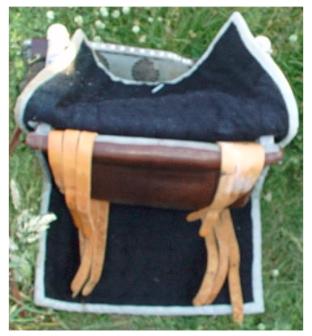
I then made a pad for the seat, also of closed cell foam, to fit the tree, and covered the top, sides and part of the underside like a cushion with upholstery velvet, with piping at the edges. Again if I had been making this as a "true Medieval" saddle I wouldn't have used closed cell foam. I attached the seat to the pads with ties to make it easily removable.
underside of seat pad showing layers of closed cell foam with gray leather to cover gullet area and red upholstery velvet covering edges.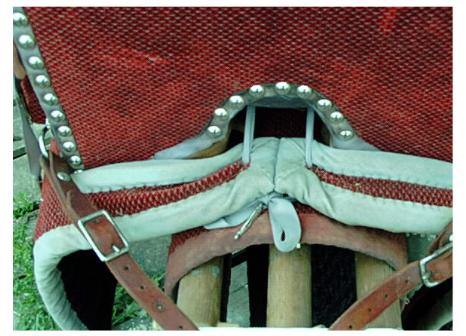
I covered the pommel and cantle with upholstery velvet outside and garment leather inside and covered the top edge with foam and leather. I used upholstery tacks to edge it.
Then I made the pads. One underpad acts as a blanket and the other pads the sides and covers the sides of the saddle to make it "finished". These I attached by screws and ties.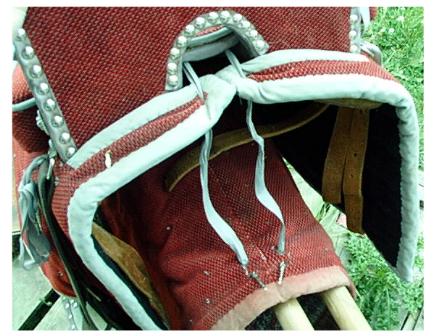
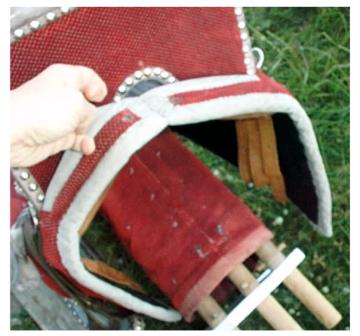
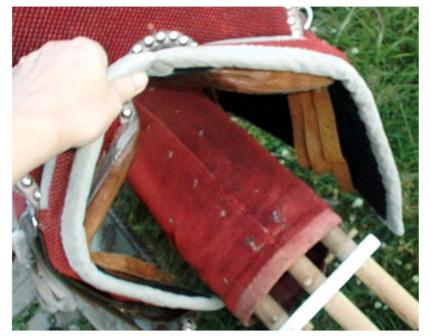
The pads and seat are removable for cleaning and to make it easy to revise if I decide to. I chose to use closed cell foam because it is inexpensive. I didn't know as I was making this saddle whether it would be possible to ride it or not and I didn't want to expend too much on what would be the first try. In period of course there was no closed cell foam. They would have used felt for padding, and felt is still one of the reliable pads for a horses back. However foam is better than felt for most padding purposes, just talk to any fighter.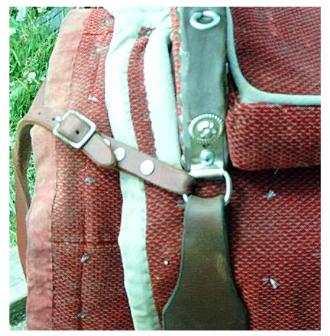
The planchet is attached to the saddle by D-rings on the cantle and pommel. The planchet leathers are purchased Australian stirrup leathers and the planchet itself is a piece of 1X6 cut to shape, painted gray, with leather and tack edging and decoration. The leathers are held to the planchet by drawer pulls.
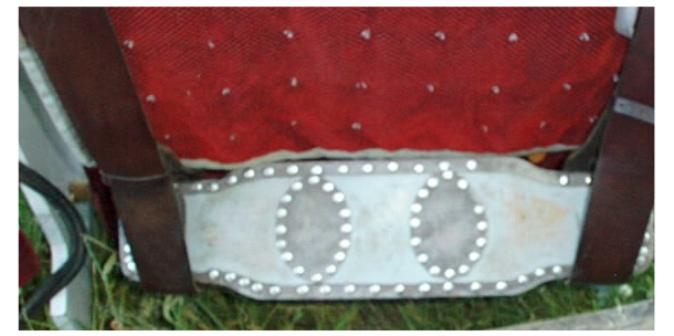
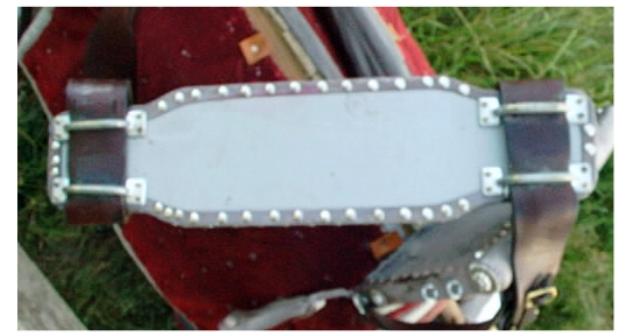
views of top and bottom of planchette
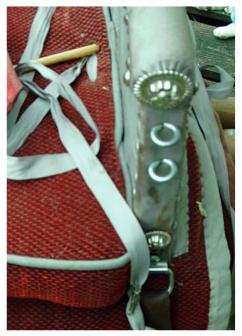

view of back attachment with and without dowel and ribbon
The back is made of fabric and cardboard laminated with glue and edged with leather. It's attached by means of eye screws and dowels.
This saddle and the one I used for inspiration are reversible. That is, you can sit the horse to either the near or off side. I think that this is due to fact that either side was correct in our period.
Finally I decorated the ends of the pommel and cantle with purchased screw back rose conchos, and put one in the center front of the pommel so it would be easy to tell which end was front.
I built this saddle because I am a member of the Society for Creative Anachronism, a non-profit educational organization that studies the Middle Ages and Renaissance.
I've been active with horses in this group for about 20 years and have been researching riding styles for most of that time. Women's riding especially interests me, and I have devoted much of my research time to it. I could never figure out why women were willing to ride in a style that all the popular (modern)authors say was dangerous or at least not comfortable. I decided that I needed to make one to do a little empirical study on the subject.
This saddle is now over eight years old. I haven't used it in the few years as it was fitted very closely to my horse and she has died of old age.
We did use it for several years though. It is comfortable to ride in, although strange at first. The motion goes side to side(mine) rather than the usual front and back. I found I liked to ride to the offside. That way I could "steer" with my left hand and use the "weapons" with my right.
It is quite safe. I only ever came out of it once and I ended up sitting upright on the ground.
I found that I could do everything I wanted to on it except mount from the ground. I am 5'10" and my horse was 15 hands. Though I can get my foot to the planchet from the ground, it is uncomfortably high. So I always used a mounting block.
My horse gave me no trouble with it. I put it on her and got on. She neck reined and went with "kissy" noises. She needed minimal leg cues anyway and one sided cues did't seem to bother her. I didn't bother with lead changes, letting her choose for herself which to take, when playing games on this saddle.
Riding at the canter is no problem and quite comfortable sideways. The major problem with riding completely aside is looking behind you.
Stay tuned to this page as more pictures and "stuff" is coming!"
These are by no means the only books I looked at in compiling this paper,
but it hits the highlights.
EQUUS
The Horse in the Roman World
Ann Hyland
Yale University Press,
New Haven and London, 1990
The Fourteenth & Fifteenth Centuries,
a visual history of costume
Margaret Scott
B T Batsford, Ltd.
London 1986
Hispanic Costume, 1480-1530
Ruth Matilda Anderson
Printed by order of the Trustees
The Hispanic Society of America
New York 1979
The Horseman's Progress,
The Development of Modern Riding
Vladimir Littauer
D. Van Nostrand Co., Inc.
Princeton, NJ 1962
Horses and Horsemanship Through the Ages
Luigi Gianoli
Crown Publishers
New York 1967
The Howell Book of Saddlery and Tack
ed. Elwyn Hartley-Edwards
Howell
New York 1988
Horse Tack
The complete equipment guide
for riding and driving
Ed. Julie Richardson
William Morrow and Co. Inc., London 1981
Late Gothic Europe, 1400-1500,
the history of dress series
Margaret Scott
Mills & Boon Ltd.
London, Sydney, Toronto 1980
Humanities Press
New Jersey
The Life, History and Magic of the Horse.
Donald Braider
Madison Square Press
Grosset & Dunlap, Publishers,
New York, 1973
Man and the Horse,
A. Mackay-Smith, J.R. Druesedow
T. Ryder
Simon and Schuster, New York, 1984
The Medieval Horse and its Equipment
c. 1150-c.1450
ed. John Clark
Museum of London, London, 1995
Medieval Pagent
Brian Holme
Thames and Hudson
New York 1987
The Pictorial Arts of the West 800-1200
C.R. Dodwell
Yale University press,
New Haven & London, 1993
The Reign of Chivalry
Richard Barber
St. Martin's Press
New York 1980
Renaissance Dress in Italy 1400-1500,
the history of dress series
Jacqueline Herald
Bell & Hyman
London 1981
Humanities Press, New Jersey
The Royal Horse of Europe
Sylvia Loch
J.A. Allen & Co. Ltd., London, 1986
The Saddle of Queens
Lida Fleitmann-Bloodgood
J.A. Allen and Co.
London 1959
Saddles
Russel H. Beatie
University of Oklahoma Press,
Norman & London, 1981
The Sixteenth Century,
A visual history of costume
Jane Ashelford
B T Batsford Ltd.
London 1983
Drama Book Publishers
New York
Woman & Horses
Gillian Newsum
Howell Book House, Inc.,
New York, NY, 1988
| Home |
| Email me |
| Top of Page |